An NOR Investment *
The term investment refers to the process of placing someone’s remains into a natural organic reduction vessel encased in the organic matter and organisms needed to transform the remains into soil. It’s similar to how the term investment is used in lost-wax investment casting, a process in which a worn out piece of jewelry is recast into a new form. /p>
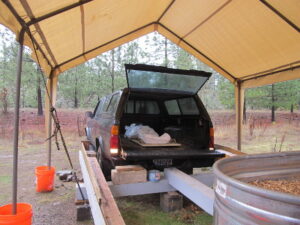 On Sunday, December 20, 2020, Herland Forest performed what we believe to be the first NOR investment to take place under Washington state’s new law. Since we’re getting inquiries about how the process works, I’ve put together some pictures that illustrate what’s involved.
On Sunday, December 20, 2020, Herland Forest performed what we believe to be the first NOR investment to take place under Washington state’s new law. Since we’re getting inquiries about how the process works, I’ve put together some pictures that illustrate what’s involved.
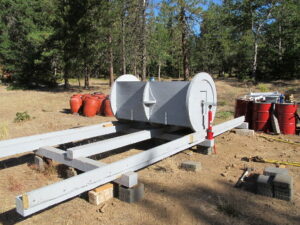 The NOR Cradle sits on a twenty-foot long rack where it can roll be rolled back and forth by hand during the reduction process. When the organisms reducing the remains start to run out of oxygen, the temperature inside the Cradle will start to fall. At that point, we roll the cradle to the other end of the rack and than back again to mix things up. It’s the same sort of thing one would do with any other compost pile to ensure aeration, only in this case, the materials are fully contained inside the Cradle.
The NOR Cradle sits on a twenty-foot long rack where it can roll be rolled back and forth by hand during the reduction process. When the organisms reducing the remains start to run out of oxygen, the temperature inside the Cradle will start to fall. At that point, we roll the cradle to the other end of the rack and than back again to mix things up. It’s the same sort of thing one would do with any other compost pile to ensure aeration, only in this case, the materials are fully contained inside the Cradle.
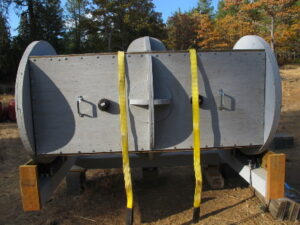 Here’s a pic of the Cradle after its been rolled to the end of the Rack. The yellow straps are what the operator uses to pull the Cradle along the track.
Here’s a pic of the Cradle after its been rolled to the end of the Rack. The yellow straps are what the operator uses to pull the Cradle along the track.
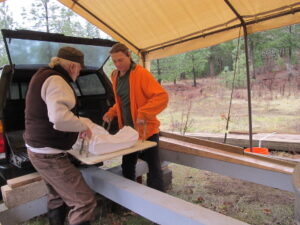 Kiri and I lifting the remains from the transport vehicle and resting them first on the Rack’s center beam, and then on top of the trough that contains the second half of the investment materials.
Kiri and I lifting the remains from the transport vehicle and resting them first on the Rack’s center beam, and then on top of the trough that contains the second half of the investment materials.
In the fall, while we were awaiting the arrival of the first decedent, we loaded up the Cradle with 200 gallons of wood chips, and ran a series of tests. The goal was to log baseline data as to how the system performed independent of the decomposition process.
One question we wanted field data on was that of how well the insulated Cradle retained its internal temperature. All sides of the Cradle are insulated to a value of R-10 to retain the heat produced by the bacterial action, but we were eager to find out how well the insulation performed in cold weather. We were quite impressed when the first snow of the season left an inch of snow on the Cradle, but didn’t affect the Cradle’s internal temperature.
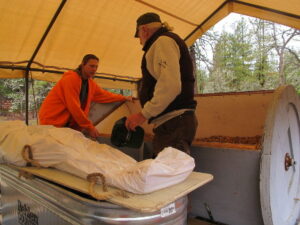 The next step involved transferring the remains to the cradle. Since the cradle is easily rotated by hand, there’s no need to lift the remains up over the side of the Cradle; we just rotated the Cradle so that the remains could be transferred horizontally. Then the Cradle was rotated back until the opening was straight up.
The next step involved transferring the remains to the cradle. Since the cradle is easily rotated by hand, there’s no need to lift the remains up over the side of the Cradle; we just rotated the Cradle so that the remains could be transferred horizontally. Then the Cradle was rotated back until the opening was straight up.
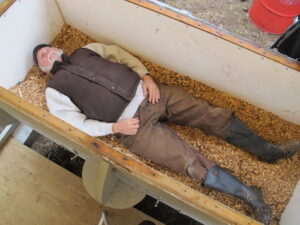 Out of regard for the decedent’s privacy, we’re not showing how the remains were laid to rest inside the Cradle. Instead, here’s a shot with me laying inside the Cradle on the bed of wood chips. I’m 5’10”, so you can see that the cradle can easily accommodate someone who’s up to 6’6″ in height.
Out of regard for the decedent’s privacy, we’re not showing how the remains were laid to rest inside the Cradle. Instead, here’s a shot with me laying inside the Cradle on the bed of wood chips. I’m 5’10”, so you can see that the cradle can easily accommodate someone who’s up to 6’6″ in height.
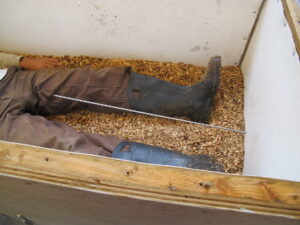 A key requirement for natural organic reduction is that the remains reach a temperature of at least 131degF and hold that temp for three days. This picture shows the probe that allows us to track the temperature at the center of the Cradle during the reduction process.
A key requirement for natural organic reduction is that the remains reach a temperature of at least 131degF and hold that temp for three days. This picture shows the probe that allows us to track the temperature at the center of the Cradle during the reduction process.
 Washington law requires that remains be transported in a leak proof containment. That requirement is usually satisfied by encasing the remains in a large, plastic bag. That’s not an impediment for cremation because it will burn up in the oven, but for the natural organic reduction process to operate, the plastic bag has to be removed.
Washington law requires that remains be transported in a leak proof containment. That requirement is usually satisfied by encasing the remains in a large, plastic bag. That’s not an impediment for cremation because it will burn up in the oven, but for the natural organic reduction process to operate, the plastic bag has to be removed.
In Washington, a licensed natural organic reduction facility has to be operated by a person who holds a natural organic reduction facility operator’s license. So far, so good in that I hold the first such license to be granted by the Cemetery Board. The problem is that under Washington law, only someone who holds a Funeral Director or Embalmer License can remove the plastic bag and any shrouding from the remains.
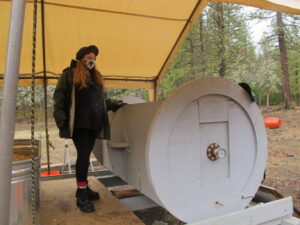 To comply with the legal requirements, we asked Elizabeth Fournier, the Funeral Director of Cornerstone Funeral, to come and assist with the investment. Elizabeth was accompanied by her daughter Sophia who took the excellent pics that accompany this article. Thanks, Sophia!
To comply with the legal requirements, we asked Elizabeth Fournier, the Funeral Director of Cornerstone Funeral, to come and assist with the investment. Elizabeth was accompanied by her daughter Sophia who took the excellent pics that accompany this article. Thanks, Sophia!
Another key function that Elizabeth performed was the authentication that the remains being prepared for reduction were the remains of the person who’s disposition had been authorized.
In the case of a burial, if some dispute arises later as to whether the person authorizing the disposition had the legal authority to do so, then the remains can be exhumed and buried elsewhere or handled in some other manner. In the case of natural organic reduction, cremation and alkaline hydrolysis, the process is irreversible. In each of those three methods of disposition, once the container is sealed, there’s no going back. Having a licensed professional confirm and sign off on the identity of the decedent is an important step in making sure that no mistake has been made.
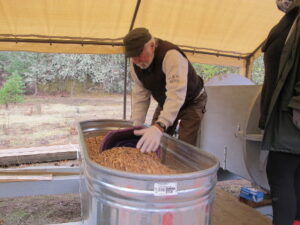 Once the decedent was laid to rest on the first half of the wood chips, it was time to add the remainder of the material needed to balance out the carbon-to-nitrogen ratio.
Once the decedent was laid to rest on the first half of the wood chips, it was time to add the remainder of the material needed to balance out the carbon-to-nitrogen ratio.
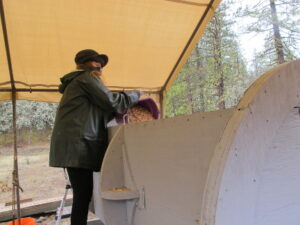 Rather than just rely on the bacteria naturally found within a person’s digestive system, we enhance the reduction process by adding a commercial inoculant that contains a mix of bacteria, protozoa and fungi.
Rather than just rely on the bacteria naturally found within a person’s digestive system, we enhance the reduction process by adding a commercial inoculant that contains a mix of bacteria, protozoa and fungi.
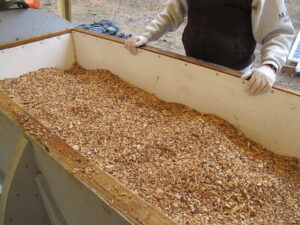 The goal in using a wide-spectrum inoculant is to diversify the biological pathways, thereby both accelerating the reduction process and ensuring a comprehensive reduction.
The goal in using a wide-spectrum inoculant is to diversify the biological pathways, thereby both accelerating the reduction process and ensuring a comprehensive reduction.
With the addition of the remaining biomass, the investment is complete.
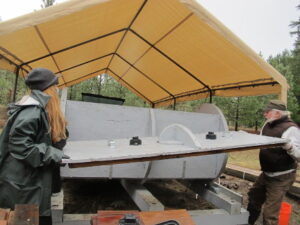 The next step is to mount the lid on the Cradle and bolt it in place.
The next step is to mount the lid on the Cradle and bolt it in place.
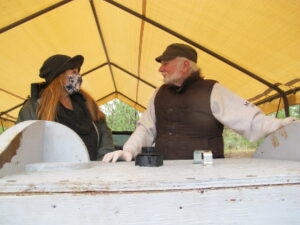 With the lid bolted on, the investment is complete.
With the lid bolted on, the investment is complete.
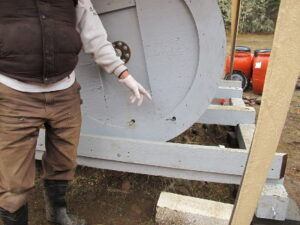 Here, I’m pointing out two key parts of the process. The device on the left is the inlet port for the Cradle’s hyperbaric oxygenation system. As the reduction organisms do their work, they need an ongoing supply of oxygen.
Here, I’m pointing out two key parts of the process. The device on the left is the inlet port for the Cradle’s hyperbaric oxygenation system. As the reduction organisms do their work, they need an ongoing supply of oxygen.
When the oxygen level inside the Cradle falls, the aerobic organisms will slow down. We can track that by noting the Cradle’s internal temp, and when it starts to fall below 145degF, we’ll add more oxygen to the system to keep it in the 145-155 degF range. Tumbling the system helps to disperse oxygen throughout the chamber, but tumbling won’t help unless the overall oxygen level is kept up.
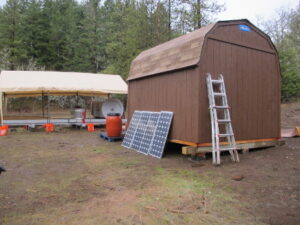 The other thing to the right of my hand is the connection for the off-grid heating element that is incorporated into the Cradle’s bottom. This 150 watt heater is specially designed to operate off the the voltage produced by the system’s photo-voltaic panels.
The other thing to the right of my hand is the connection for the off-grid heating element that is incorporated into the Cradle’s bottom. This 150 watt heater is specially designed to operate off the the voltage produced by the system’s photo-voltaic panels.
Between the ability to add oxygen and heat as needed, our system will keep the reduction going regardless of the weather. Even so, the process is still going to take longer in winter than in summer, but that’s okay with us. We see this as a hand-crafted method of disposition that works with nature, rather than an industrial process that rushes things.
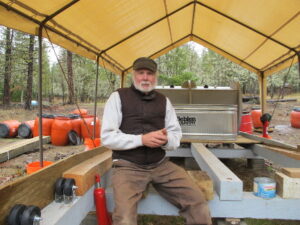 Well, that’s an introduction to how we undertake the initial steps in our natural organic reduction process. If you have more questions, please feel free to reach out.
Well, that’s an introduction to how we undertake the initial steps in our natural organic reduction process. If you have more questions, please feel free to reach out.

